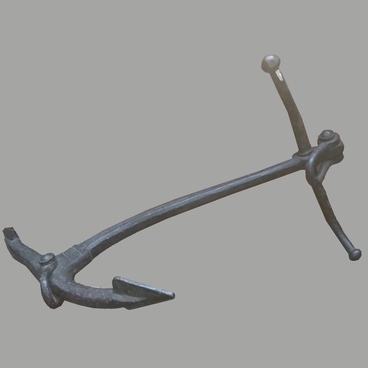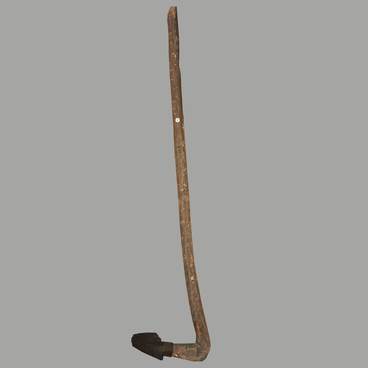Chainmail armor is a defensive armature with a protective structure made of rings, where the rings are riveted onto spikes, rather than onto nails, unlike ring armor.
This chainmail armor has a structure of a shirt with short sleeves and a split collar with a thickened part on the chest. It was most probably created by Russian blacksmiths in the 16th or 17th centuries. This conclusion was influenced by a discussion regarding the cultural attribution of chainmail armors found in the Altai Mountains. In the ensuing discussion, L.A. Bobrov and Yu.S. Khudyakov pointed out the features of the design of defensive armors made of rings that are characteristic of Russian masters. These features include the fastening of the collar from right to left, as well as the predominance of connecting the rings with spikes, rather than with nails. Both features are visible on the shown armor. However, the Eastern European origin of this chainmail does not preclude the possibility of its use by Tatar soldiers or the Central Asian warriors.
This armor is also interesting because it is the only protective armature based on ring mail, which was found in the territory of the Kuznetsk Tatars. In addition to this armor, two plates from kuyaks were found in the same territory; the first plate from the Bedarevskoye-I settlement, while the second one was discovered by Yu.V. Shirin at the Kuznetsk monument in 2012 and the information about it has not yet been published. It is noteworthy that researchers assumed that some objects of protective armaments from the territories adjacent to the Kuznetsk Basin were of ‘Shor production’. L.A. Bobrov and Yu.S. Khudyakov suggested that ‘as early as in the first third of the 17th century, the armorers from Shor mastered the production of the region’s most advanced ring-plate armor (called Bekhtertsy by the Russian soldiers), as well as chainmail armors.’ We have no reason to consider the exhibited armor as the work of the Kuznetsk Tatars, because we cannot use as an analogy any object of defensive armament, which could undoubtedly be considered as produced by the Kuznetsk Tatars. Typological features of Kuznetsk Tatars’ defensive armaments, necessary for the selection of analogies, cannot be found in any well-known written sources, either. It should be pointed out that, in contrast to iron making, the blacksmith craft of the Kuznetsk Tatars had not been studied, which was mentioned by Ya.I. Sunchugashev as far back as in the 1970s. Since then, only N.M. Zinyakov was able to conduct a metallographic study of the black and metal production of Kuznetsk and the surrounding villages. The Shor agricultural tools called abyl and ozyp, as well as iron balls, were among the studies objects. Further study of iron smelting and blacksmithing in the south of the Kuznetsk basin in 17th and 18th centuries will clarify the issue about supply sources of arms in the Sayan-Altai region during this period.
This chainmail armor has a structure of a shirt with short sleeves and a split collar with a thickened part on the chest. It was most probably created by Russian blacksmiths in the 16th or 17th centuries. This conclusion was influenced by a discussion regarding the cultural attribution of chainmail armors found in the Altai Mountains. In the ensuing discussion, L.A. Bobrov and Yu.S. Khudyakov pointed out the features of the design of defensive armors made of rings that are characteristic of Russian masters. These features include the fastening of the collar from right to left, as well as the predominance of connecting the rings with spikes, rather than with nails. Both features are visible on the shown armor. However, the Eastern European origin of this chainmail does not preclude the possibility of its use by Tatar soldiers or the Central Asian warriors.
This armor is also interesting because it is the only protective armature based on ring mail, which was found in the territory of the Kuznetsk Tatars. In addition to this armor, two plates from kuyaks were found in the same territory; the first plate from the Bedarevskoye-I settlement, while the second one was discovered by Yu.V. Shirin at the Kuznetsk monument in 2012 and the information about it has not yet been published. It is noteworthy that researchers assumed that some objects of protective armaments from the territories adjacent to the Kuznetsk Basin were of ‘Shor production’. L.A. Bobrov and Yu.S. Khudyakov suggested that ‘as early as in the first third of the 17th century, the armorers from Shor mastered the production of the region’s most advanced ring-plate armor (called Bekhtertsy by the Russian soldiers), as well as chainmail armors.’ We have no reason to consider the exhibited armor as the work of the Kuznetsk Tatars, because we cannot use as an analogy any object of defensive armament, which could undoubtedly be considered as produced by the Kuznetsk Tatars. Typological features of Kuznetsk Tatars’ defensive armaments, necessary for the selection of analogies, cannot be found in any well-known written sources, either. It should be pointed out that, in contrast to iron making, the blacksmith craft of the Kuznetsk Tatars had not been studied, which was mentioned by Ya.I. Sunchugashev as far back as in the 1970s. Since then, only N.M. Zinyakov was able to conduct a metallographic study of the black and metal production of Kuznetsk and the surrounding villages. The Shor agricultural tools called abyl and ozyp, as well as iron balls, were among the studies objects. Further study of iron smelting and blacksmithing in the south of the Kuznetsk basin in 17th and 18th centuries will clarify the issue about supply sources of arms in the Sayan-Altai region during this period.



